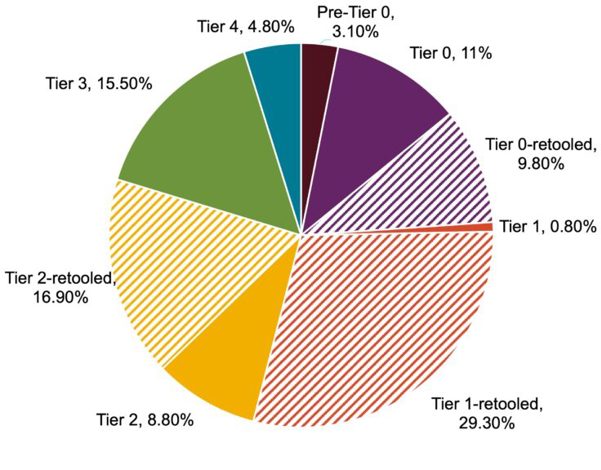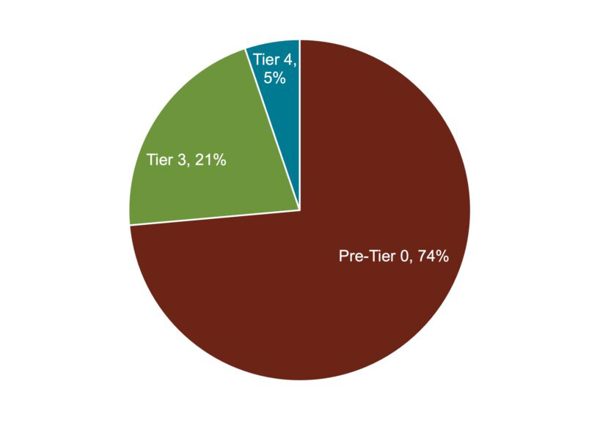The California Air Resources Board (CARB) adopted a groundbreaking regulation in late April aimed at accelerating the retirement of old, dirty diesel trains. For the first time anywhere in the United States, the In-Use Locomotive Regulation will ban locomotives that are more than 23 years old, while requiring that new zero-emission locomotives begin entering the fleet as early as 2030. This is another example of California’s leadership in using state regulations to leap toward zero-emissions transportation.
Because of federal preemption, states cannot set emission standards for new locomotives or new engines used in locomotives. CARB will instead regulate the types of engines railway companies can use and require zero-emission operations within the state.
The US Environmental Protection Agency (EPA) regulates tailpipe emissions and greenhouse gas emissions from locomotive engines at the federal level. The oldest locomotives with the least-stringent emission limits are Tier 0. New locomotives must meet the more-stringent Tier 4 standards, which were finalized in 2008 and adopted in 2015.
Even though these Tier 4 standards have been in place for almost 10 years, the locomotive fleet in California continues operating with older, dirtier diesel engines. Tier 1 and older locomotives with limited or no emission control components made up over 50% of the fleet in 2020 (see Figure 1). Cleaner Tier 4-certified engines were less than 5% of this fleet.

Figure 1: California’s locomotive fleet in 2020. Retooled engines have been remanufactured or refurbished. Source: California Air Resources Board
It gets worse: Regional and industrial locomotives that typically operate around railyards, seaports, and industrial facilities rely heavily on the dirtiest Pre-Tier 0 locomotives engines (see Figure 2). These locomotives often run close to communities with lower incomes and larger percentages of members of minority groups, resulting in a higher environmental health burden for these populations.

Figure 2: California’s regional and industrial locomotive fleet in 2022. Regional fleets pull freight over short and medium distances. Industrial locomotives typically move freight to a main track to be connected to a larger train. Source: California Air Resources Board
This is because locomotives have a long service life, with most engines staying in the fleet for about a half-century. Even though engines need to be remanufactured or refurbished – typically every seven to 10 years to ensure performance – the engines only need to comply with the standards under which they were originally certified. Extending the life of these older engines slows down the turnover of new locomotives and delays the phase-in of engines meeting more stringent standards.
California’s innovative approach to accelerating the adoption and use of zero-emission technology will deliver important benefits to the state’s communities. The in-use regulation is expected to avoid about 90% of locomotive particulate matter (PM) and nitrogen oxides (NOX) emissions by 2050. That can be translated to avoided emissions of nearly 7,000 tons of PM, 386,000 tons of NOx, and 21 million tons of GHG cumulatively from now through 2050.
While celebrating this great milestone, it is worth noting that the issue with dirty diesel engines dominating the fleet is not unique to California. Less than 1% of tracks in the US run electrified trains and less than 10% of the national fleet is Tier 4-certified. Roughly half of all locomotive engines are more than 23 years old and so have little or no emission controls. These old engines are expected to remain in the national fleet for another decade or more if no other measures are taken.
Other states governments can follow California’s lead in cleaning up the locomotive fleet. The EPA’s recent proposed revision on state preemption sent a clear supporting signal for California’s action and would allow other states to regulate locomotive emissions; multiple states adopted California’s 2035 zero-emission vehicle mandates and Advanced Clean Trucks Regulations. With more states setting stringent in-use requirements, railway companies will be required to extend the environmental and health benefits of zero-emission rail beyond California.
The federal government can also increase its commitment to clean up the locomotive fleet. The EPA could set more stringent emission standards for new locomotive engines. Tier 5 emission standards, suggested by California in a 2017 petition letter, are a good start. Increased stringency for these remanufactured or refurbished engines would further accelerate the upgrading of old engines with the latest emission-control technologies. Funding, such as that contained in the Consolidated Rail Infrastructure and Safety Improvements grant program, could largely support and accelerate the transition.
California’s in-use locomotive regulation signals the start of an era of transitioning the US railway system to zero emissions. Other states and the federal government should get on board the express train to clean up dirty diesel engines.
This article was first published by the International Council on Clean Transportation here.

